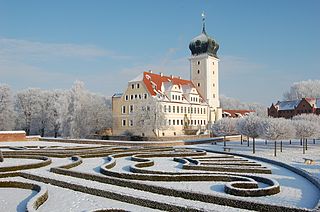
Bischofswerda is a small town in eastern Germany at the western edge of Upper Lusatia in Saxony.

Delitzsch is a town in Saxony in Germany, 20 km north of Leipzig and 30 km east of Halle (Saale). With 24,850 inhabitants at the end of 2015, it is the largest town in the district of Nordsachsen.

Böhlen is a town in Saxony, Germany, south of Leipzig. Its main features are a small airport and a power plant. It is located in the newly built Neuseenland, the lakes created in former open-pit mining areas.

Herrnhut is an Upper Lusatian town in the Görlitz district in Saxony, Germany, known for the community of the Moravian Church established by Nicolas Ludwig, Count von Zinzendorf, in 1722. In 2024, the town was inscribed on World Heritage List as a part of the serial site of Moravian Church Settlements.

Mittweida is a town in Saxony, Germany, in the Mittelsachsen district.

Waldenburg is a town in the district Zwickau in Saxony, Germany. The castle was owned by the House of Schönburg from 1378 until 1945. The pottery town of Waldenburg lies in the valley of the Zwickauer Mulde. The environment is characterized by forest areas, river meadows and the hilly landscape of the Erzgebirge foothills.

Sohland an der Spree (German) or Załom is a municipality in the district of Bautzen in Saxony, Germany near the border of the Czech Republic in a region called Lusatia. The river Spree flows through the village. Together with some smaller villages it constitutes one of the biggest villages or communities with about 7,700 inhabitants. The most iconic monument of the village is the "Himmelsbrücke" ; it is said that the bridge will break when someone tells a lie while standing on it.

Wurzen is a town in the Leipzig district, in Saxony, Germany. It is situated on the river Mulde, here crossed by two bridges, 25 km east of Leipzig, by rail N.E. of Leipzig on the main line via Riesa to Dresden. It has a cathedral dating from the twelfth century, a castle, at one time a residence of the bishops of Meissen and later utilized as law courts, several schools, an agricultural college and as a police station including a prison.

Eibenstock is a town in the Erzgebirgskreis, Saxony, Germany. It is situated in the western Ore Mountains, near the river Mulde.

Borna is a town in Saxony, Germany, capital of the Leipzig district. It is situated approximately 30 km southeast of Leipzig city. It has approx. 19,000 inhabitants. The town is the district seat of the district of Leipzig.

Olbernhau is a town in the district Erzgebirgskreis, in Saxony, Germany. It is situated in the Ore Mountains, 35 km southeast of Chemnitz, and 23 km north of Chomutov, Czech Republic.

Bad Elster is a spa town in the Vogtlandkreis district, in Saxony, Germany. It lies on the border of Bavaria and the Czech Republic in the Elster gebirge hills. It is situated on the river White Elster, and is protected from extremes of temperature by the surrounding wooded hills. It is 25 kilometres (16 mi) southeast of Plauen, and 25 kilometres (16 mi) northwest of Cheb. It is part of the Freunde im Herzen Europas microregion.

Bernstadt auf dem Eigen is a town in the Görlitz district, in Saxony, Germany. It is situated 16 km north of Zittau, and 16 km southwest of Görlitz.

Frauenstein is a town in the district of Mittelsachsen, in Saxony, Germany. It is situated in the eastern Ore Mountains, 19 km (11.81 mi) southeast of Freiberg, and 33 km (20.51 mi) southwest of Dresden.

Geringswalde is a town in the district of Mittelsachsen, in Saxony, Germany. It is situated 12 km northwest of Mittweida, and 27 km north of Chemnitz.

Gröditz is a town in the district Meißen, in Saxony, Germany. The town is located 12 km northeast of Riesa, and 7 km southwest of Elsterwerda.

Klingenthal is a town in the Vogtland region, in Saxony, south-eastern Germany. It is situated directly on the border with the Czech Republic opposite the Czech town of Kraslice, 29 km southeast of Plauen, and 33 km northwest of Karlovy Vary. It is part of the Musikwinkel, a historical center of musical instrument manufacturing.
Adolf Gottlieb Fiedler was a German entrepreneur in Saxony and Poland.

Mücka (German) or Mikow is a municipality in the district of Görlitz, Saxony, Germany.

Alexander Gerd Krauß is a German politician who served as a member of the German Bundestag from 2017 to 2021. From 2004 until 2017 he was a member of the Landtag of the Free State of Saxony.
























